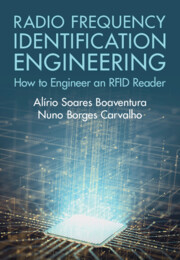
-
Select format
-
- Publisher:
- Cambridge University Press
- Publication date:
- January 2025
- January 2025
- ISBN:
- 9781108779265
- 9781108489713
- Dimensions:
- (244 x 170 mm)
- Weight & Pages:
- 0.63kg, 266 Pages
- Dimensions:
- Weight & Pages:
- Subjects:
- Engineering, Electromagnetics, RF and Microwave Engineering
You may already have access via personal or institutional login- Subjects:
- Engineering, Electromagnetics, RF and Microwave Engineering
Book description
Radio Frequency Identification Engineering Radio frequency identification (RFID) has become an undeniable aspect of modern living, being used from logistics, access control, and electronic payment systems to artificial intelligence, and as a key building block of the internet of things. Presenting a unique coverage of RFID reader design and engineering, this is a valuable resource for engineers and researchers, aiding in their mission of fulfilling current and future demands in the RFID space. Providing a cohesive compilation of technical resources for full-stack engineering of RFID readers, the book includes step-by-step techniques, algorithms, and source code that can be incorporated in custom designs. Readers are invited to explore the design of RFID interrogators based on software-defined radio for flexible, upgradeable solutions as well as low-complexity techniques for engineering low-cost RFID readers. Additionally, the authors provide insight into related topics such as waveform design optimization for improved reading range and novel quadrature backscatter modulation techniques.
Reviews
‘This book is a must-have reference handbook for researchers aspiring to design and build a versatile functional software-defined RFID reader. It is also one of the best resources for anyone looking to learn more about the world of RAIN RFID (RAdio IdentificatioN RFID). This highly recommended book covers a wide range of topics, starting from spectrum, standards, backscatter technology definitions, and all the way to reader architecture choices and RFID signal processing, including encoding, modulation, and filtering. With sections on advanced research concepts, such as multicarrier systems or adaptive self-jamming suppression, as well as many exercises and practical MATLAB code examples, it can be used as a great text-book for students.’
James Chu Source: IEEE Microwave Magazine
Contents
Metrics
Full text views
Full text views help Loading metrics...
Loading metrics...
* Views captured on Cambridge Core between #date#. This data will be updated every 24 hours.
Usage data cannot currently be displayed.
Accessibility standard: Unknown
Why this information is here
This section outlines the accessibility features of this content - including support for screen readers, full keyboard navigation and high-contrast display options. This may not be relevant for you.
Accessibility Information
Accessibility compliance for the PDF of this book is currently unknown and may be updated in the future.

